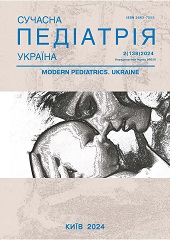Topography and dimensions of the auditory tube at the end of the fetal period
DOI:
https://doi.org/10.15574/SP.2024.138.86Keywords:
anatomy, premature babies, auditory tubeAbstract
Introduction. Otitis media in premature newborns and term newborns is a serious problem due to the immaturity of the organs and systems of these children and the difficulty of their adaptation. This often leads to the development of pathological changes in the hearing organ and the need for surgical intervention.
The aim - to find out the topographic and anatomical features of the auditory tube at the end of the fetal period to improve technologies and the adequacy of surgical treatment.
Material and methods. The study was performed on 35 human fetuses of 231.0-375.0 mm parietococcygeal length (PCL) and 11 neonatal cadavers. In the course of the study the following methods were used: thin dissection of the middle ear and adjacent areas under the control of a binocular loupe; macro- and microscopy; morphometry; macro photography with digital camera "OLIMPUS μ 1000 All-weather 10.0 MPix".
Results. It has been established that the size and shape of the auditory tube in premature babies do not have definitive dimensions and its location differs from that in term newborns. The pharyngeal openings of the auditory tubes are located at the level of the hard palate, and in term newborns - above the level of the hard palate. The tympanic openings from the lower part of the anterior wall of the tympanic cavity in fetuses of the seventh month of intrauterine growth completely move to its upper part and open into the supratympanic space in fetuses of the tenth month.
Conclusions. The defined features of the development of the auditory tube at the end of the fetal period are important for the improvement of technologies and the adequacy of surgical treatment and manipulations in premature babies and term newborns.
The research was carried out in accordance with the principles of the Declaration of Helsinki. The study protocol was approved by the Local Ethics Committee of the institution indicated in the work.
No conflict of interests was declared by the authors.
References
Block SL. (2012). Management of acute otitis media in afebrile neonates. Pediatr Ann. 41(06): 225-228. https://doi.org/10.3928/00904481-20120524-04; PMid:22694232
Coticchia J, Shah P, Sachdeva L, Kwong K, Cortez JM et al. (2014). Frequency of Otitis Media Based on Otoendoscopic Evaluation in Preterm Infants. Otolaryngology - Head and Neck Surgery. 151(4): 692-699. https://doi.org/10.1177/0194599814544887; PMid:25151486
Fuchs JC, Tucker AS. (2015). Development and Integration of the Ear. Curr Top Dev Biol. 115: 213-232. https://doi.org/10.1016/bs.ctdb.2015.07.007; PMid:26589927
Hayashi T, Kitamura K, Hashimoto S, Hotomi M, Kojima H, Kudo F et al. (2020, Aug). Clinical practice guidelines for the diagnosis and management of acute otitis media in children-2018 update. Auris Nasus Larynx. 47(4): 493-526. https://doi.org/10.1016/j.anl.2020.05.019; PMid:32576390
Imterat M, Wainstock T, Moran-Gilad J, Sheiner E, Walfisch A. (2019, Apr). The association between gestational age and otitis media during childhood: a population-based cohort analysis. J Dev Orig Health Dis. 10(2): 214-220. https://doi.org/10.1017/S2040174418000685; PMid:30223907
Janwadkar A, Louis S, Nemerofsky SL. (2021). Acute Otitis Media in an Extremely Preterm Infant. AJP Rep. 11: e99-e101. ISSN 2157-6998. https://doi.org/10.1055/s-0041-1731315; PMid:34178425 PMCid:PMC8221837
Lieberthal AS, Carroll AE, Chonmaitree T et al. (2013). The diagnosis and management of acute otitis media. Pediatrics. 131: e964-e999. https://doi.org/10.1542/peds.2012-3488; PMid:23439909
Marom T, Kraus O, Habashi N, Tamir SO. (2019). Emerging Technologies for the Diagnosis of Otitis Media. Otolaryngology - Head and Neck Surgery. 160(3): 447-456. https://doi.org/10.1177/0194599818809337; PMid:30396324
Myburgh HC, van Zijl WH, Swanepoel D, Hellstrom S, Laurent C. (2016). Otitis media diagnosis for developing countries using tympanic membrane image-analysis. EBioMedicine. 5: 156-160. https://doi.org/10.1016/j.ebiom.2016.02.017; PMid:27077122 PMCid:PMC4816811
Ovnat Tamir S, Shemesh S, Oron Y, Marom T. (2017). Acute otitis media guidelines in selected developed and developing countries: uniformity and diversity. Arch Dis Child. 102: 450-457. https://doi.org/10.1136/archdischild-2016-310729; PMid:27601361
Pellegrini S, Gonzalez Macchi ME, Sommerfleck PA et al. (2012). Intratemporal complications from acute otitis media in children: 17 cases in two years. Acta Otorrinolaringol Esp. 63: 21-25. https://doi.org/10.1016/j.otoeng.2011.06.005
Rosenfeld RM, Tunkel DE, Schwartz SR, Anne S, Bishop CE, Chelius DC et al. (2022, Feb). Clinical Practice Guideline: Tympanostomy Tubes in Children (Update). Otolaryngol Head Neck Surg. 166; suppl 1: S1-S55. https://doi.org/10.1177/01945998211065662; PMid:35138954
Schilder AG, Chonmaitree T, Cripps AW et al. (2016, Sep 8). Otitis media. Nat Rev Dis Primers. 2(1): 16063. https://doi.org/10.1038/nrdp.2016.63; PMid:27604644 PMCid:PMC7097351
Schilder AG, Marom T, Bhutta MF et al. (2017). Panel 7: otitis media: treatment and complications. Otolaryngol Head Neck Surg. 156(4); suppl: S88-S105. https://doi.org/10.1177/0194599816633697; PMid:28372534
Suzuki HG, Dewez JE, Nijman RG, Yeung S. (2020, May 5). Clinical practice guidelines for acute otitis media in children: a systematic review and appraisal of European national guidelines. BMJ Open. 10(5): e035343. https://doi.org/10.1136/bmjopen-2019-035343; PMid:32371515 PMCid:PMC7228535
Downloads
Published
Issue
Section
License
Copyright (c) 2024 Modern pediatrics. Ukraine

This work is licensed under a Creative Commons Attribution-NonCommercial 4.0 International License.
The policy of the Journal “MODERN PEDIATRICS. UKRAINE” is compatible with the vast majority of funders' of open access and self-archiving policies. The journal provides immediate open access route being convinced that everyone – not only scientists - can benefit from research results, and publishes articles exclusively under open access distribution, with a Creative Commons Attribution-Noncommercial 4.0 international license (СС BY-NC).
Authors transfer the copyright to the Journal “MODERN PEDIATRICS. UKRAINE” when the manuscript is accepted for publication. Authors declare that this manuscript has not been published nor is under simultaneous consideration for publication elsewhere. After publication, the articles become freely available on-line to the public.
Readers have the right to use, distribute, and reproduce articles in any medium, provided the articles and the journal are properly cited.
The use of published materials for commercial purposes is strongly prohibited.

